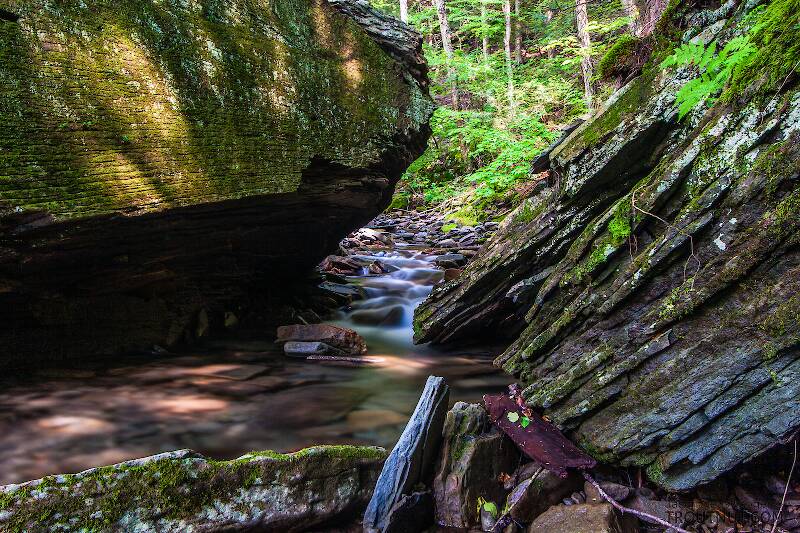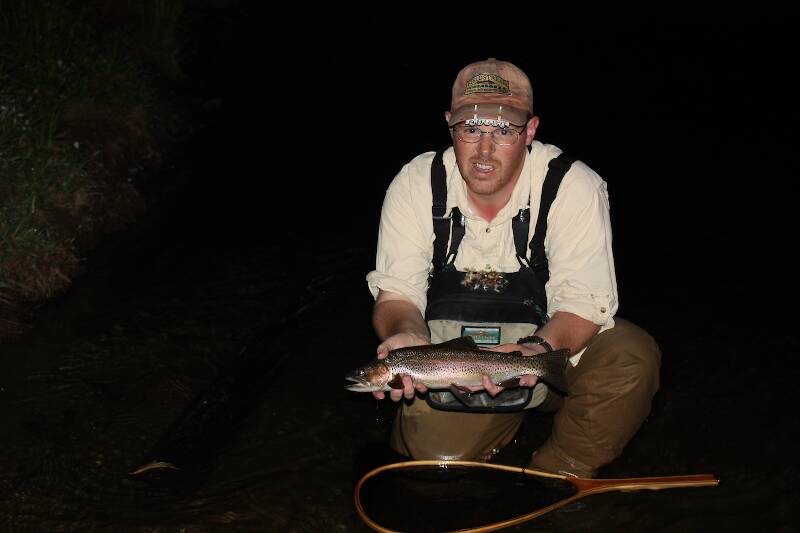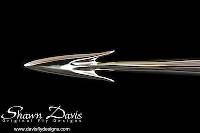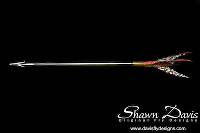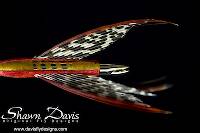
Blue-winged Olives
Baetis
Tiny Baetis mayflies are perhaps the most commonly encountered and imitated by anglers on all American trout streams due to their great abundance, widespread distribution, and trout-friendly emergence habits.
Featured on the forum


Troutnut is a project started in 2003 by salmonid ecologist Jason "Troutnut" Neuswanger to help anglers and
fly tyers unabashedly embrace the entomological side of the sport. Learn more about Troutnut or
support the project for an enhanced experience here.
Lam on Oct 10, 2007October 10th, 2007, 8:51 am EDT
Or have an opinion of them? I have read various articles that they should be in every western fly box. Are they as prevalent in the East or haven't they proven that effective? I would like to tie some in various colors and try them out. For anyone in the east with experience, what colors would you recommend?
Thanks,
Lam
Thanks,
Lam
JOHNW on Oct 10, 2007October 10th, 2007, 9:37 am EDT
LAM-
I can't say I'm a big fan of the CJ however I'm almost strictly an eastern guy (probably would head west more if $ and family weren't factors but wouldn't we all) who is blessed to be nestled among spring creeks.
Most of the guys I know that carry them carry Green, copper/brass, and red. One guy swears by black or brown for fussy steelhead in clear water.
As for the overall effectiveness of the fly I have a hunch that it has more to do with the fact that all of that weight gets the fly down fast and then keeps it there longer. This essentially presents the fly to more fish each cast.
Again just my humble $.02
JW
I can't say I'm a big fan of the CJ however I'm almost strictly an eastern guy (probably would head west more if $ and family weren't factors but wouldn't we all) who is blessed to be nestled among spring creeks.
Most of the guys I know that carry them carry Green, copper/brass, and red. One guy swears by black or brown for fussy steelhead in clear water.
As for the overall effectiveness of the fly I have a hunch that it has more to do with the fact that all of that weight gets the fly down fast and then keeps it there longer. This essentially presents the fly to more fish each cast.
Again just my humble $.02
JW
"old habits are hard to kill once you have gray in your beard" -Old Red Barn
Dryfly on Oct 10, 2007October 10th, 2007, 9:44 am EDT
Tie them up! I caught my biggest fish of the year a 17 incher on one. My favorite color in the standard copper. Experiment with color choices, thats the fun of tying.
RleeP on Oct 10, 2007October 10th, 2007, 12:25 pm EDT
I've found CJ's to be pretty effective in the spring creeks of WI and NE Iowa. I've not done worth a rooty-toot with them on the Sand Country streams of Central WI.
Generally, the ones I've had the best luck with are made with that dark green ultra wire (not olive)in sizes 16 and 18. I don't know why these green ones work so well. They don't look like anything natural I know of in these creeks. I've also fished some small red ones and caught a few fish that were (my guess) accidently hooked when their jaws dropped in amazement at this little red thing going by...:). I can't really see it as being deliberate. Copper CJs work too, but I fish very few copper CJs. I'm carrying about 400 PT nymphs at any given time (or so it seems) and they fill that slot for me.
My guess (untested) would be that they would work OK in most of the PA limestones that show a little of that (for lack of a better phrase) "carbonate murk" like Penns and Spring and the Kish, etc., but not so well on the small to medium freestones. There are a lot of flies like that.
Generally, the ones I've had the best luck with are made with that dark green ultra wire (not olive)in sizes 16 and 18. I don't know why these green ones work so well. They don't look like anything natural I know of in these creeks. I've also fished some small red ones and caught a few fish that were (my guess) accidently hooked when their jaws dropped in amazement at this little red thing going by...:). I can't really see it as being deliberate. Copper CJs work too, but I fish very few copper CJs. I'm carrying about 400 PT nymphs at any given time (or so it seems) and they fill that slot for me.
My guess (untested) would be that they would work OK in most of the PA limestones that show a little of that (for lack of a better phrase) "carbonate murk" like Penns and Spring and the Kish, etc., but not so well on the small to medium freestones. There are a lot of flies like that.
Lam on Oct 10, 2007October 10th, 2007, 1:14 pm EDT
Thanks for the input, guys.
Shawnny3 on Oct 10, 2007October 10th, 2007, 2:41 pm EDT
I have a pattern I like that is based on the Copper John but is different enough that I don't feel guilty calling it my own. I'll PM you the recipe, Lam.
-Shawn
-Shawn
Jewelry-Quality Artistic Salmon Flies, by Shawn Davis
www.davisflydesigns.com
www.davisflydesigns.com
Lam on Oct 10, 2007October 10th, 2007, 2:50 pm EDT
I look forward to it Shawnny3.
When I tie mine up I was thinking of using the rubber leg and tail variation as opposed to the feather tail and legs. Any opinions on that?
When I tie mine up I was thinking of using the rubber leg and tail variation as opposed to the feather tail and legs. Any opinions on that?
Shawnny3 on Oct 10, 2007October 10th, 2007, 2:58 pm EDT
I'm not that fond of rubber legs myself (simply and aesthetic choice - I'm sure they work well). The tailing material I'm familiar with for them is goose biots, but I prefer mallard flank, especially for smaller variations.
I've just PMed you a pretty detailed recipe.
-Shawn
I've just PMed you a pretty detailed recipe.
-Shawn
Jewelry-Quality Artistic Salmon Flies, by Shawn Davis
www.davisflydesigns.com
www.davisflydesigns.com
Davez on Oct 11, 2007October 11th, 2007, 5:01 am EDT
i like regular old bead head pheasant tails. however the merit of the CJ is that it is one durable mother of a fly. i have rusted them apart before the materials fell off the hook.
i like them when they get used and old and dirty.
just like my women. hahahaha!
i like them when they get used and old and dirty.
just like my women. hahahaha!
Mcjames on Oct 11, 2007October 11th, 2007, 7:10 am EDT
I just tied some-- size 18 and 20-- to use instead of PT when water is a bit off color. Let you know how they do, if I ever get out again... I used really fine copper wire from some old electrical wiring I trash-picked
I am haunted by waters
Dano on Oct 12, 2007October 12th, 2007, 5:34 am EDT
Lam,
I'm a transplanted Michigander living in Southcentral Oregon...I never used CJs when back East; though I've always been a huge fan of Pheasant Tails...
Any who, they (CJs) do seem real poplar out here, so I tied up a couple. My conclusion is that they don't "perform" any better than my PTN's and they just take up space in my fly box. So, I don't bother with 'em. I should probably note that I tie my PTNs, for the most part, using the original recipie; fine copper wire instead of silk...
The only PT patterns I ever use is the above mentioned "original" and one that differs only with it's Peacock herl thorax...
I'm a firm believer of the "KISS" method. Consequently, my fly boxes have more of a variety of sizes rather than patterns (according to time of year). If I'm gonna tie on a searching pattern nymph it would either be a Prince or a G.R. Hare's Ear. FWIW.
Dano
I'm a transplanted Michigander living in Southcentral Oregon...I never used CJs when back East; though I've always been a huge fan of Pheasant Tails...
Any who, they (CJs) do seem real poplar out here, so I tied up a couple. My conclusion is that they don't "perform" any better than my PTN's and they just take up space in my fly box. So, I don't bother with 'em. I should probably note that I tie my PTNs, for the most part, using the original recipie; fine copper wire instead of silk...
The only PT patterns I ever use is the above mentioned "original" and one that differs only with it's Peacock herl thorax...
I'm a firm believer of the "KISS" method. Consequently, my fly boxes have more of a variety of sizes rather than patterns (according to time of year). If I'm gonna tie on a searching pattern nymph it would either be a Prince or a G.R. Hare's Ear. FWIW.
Dano
Davez on Oct 12, 2007October 12th, 2007, 5:54 am EDT
amen, dano.
keep it simple. i agree. most nymphs look the same, its how you weight them.
keep it simple. i agree. most nymphs look the same, its how you weight them.
Dano on Oct 12, 2007October 12th, 2007, 9:40 am EDT
Yeah, Dave...
I've been fishin' since I was old enough to hold a rod. Started fly roddin' in high school over 30 years ago. 'Course, rollin' my own flies was a natural outgrowth from that.
I was lucky enough to have "grown up" on the waters that Swisher and Richards did most of their research on. So I'm more inclined to 'speryment with my own patterns based on specimans I've collected, rather than some of these goofy foam bodied/rubber legged concoctions I see in fly shops. Hell, most of 'em look like they came from the cleaning supplies department out of a grocery store. Heheheheh...
So, for the most part, my fly boxes consist of the more "traditional" ties. Besides I learned a looooooong time ago that it's the archer not the arrow that's most important....
Dano
I've been fishin' since I was old enough to hold a rod. Started fly roddin' in high school over 30 years ago. 'Course, rollin' my own flies was a natural outgrowth from that.
I was lucky enough to have "grown up" on the waters that Swisher and Richards did most of their research on. So I'm more inclined to 'speryment with my own patterns based on specimans I've collected, rather than some of these goofy foam bodied/rubber legged concoctions I see in fly shops. Hell, most of 'em look like they came from the cleaning supplies department out of a grocery store. Heheheheh...
So, for the most part, my fly boxes consist of the more "traditional" ties. Besides I learned a looooooong time ago that it's the archer not the arrow that's most important....
Dano
Slatedrake
Posts: 1
Posts: 1
Slatedrake on Oct 23, 2007October 23rd, 2007, 12:56 pm EDT
I use them all over PA. Green and Copper, they work well. I can't say that they look like anything in the water but they do work. Probably an attractor like a Royal Coachman. It just looks like it should be eaten. :)
Psyfly on Oct 23, 2007October 23rd, 2007, 3:15 pm EDT
not a big fan of the Copper John's. I've lived in the west and still don't care for them. They are heavy and get down fast. I like using natural materials so I haven't given the fly much of a chance.
"If I might be judge, God never did make a more calm,quiet, innocent recreation than angling" Isaac Walton
www.tierneysflies.com
www.tierneysflies.com
GONZO on Oct 23, 2007October 23rd, 2007, 5:31 pm EDT
If sales are any indication, then the Copper John is a very successful fly. Of course, I always wonder if that's the sign of a successful fly, or just successful promotion. From a marketing perspective, I guess it doesn't matter. But the CJ does seem to lack the suggestive qualities of true classics like the Gold-Ribbed Hare's Ear or the Sawyer Pheasant Tail.
If you like the way the CJ fishes and catches fish, by all means, keep buying it. But if you are tying your own, there are probably a few steps you could omit without any loss of effectiveness. The CJ is another of the flies that seem determined to drift upside down. This may not be a bad thing in a fly that sinks like a rock (a very heavy rock). It won't eliminate hang ups, but it might help to keep them from being routine. From an upside-down perspective, however, the extra tying steps of adding a wingcase, flash, and epoxy seem superfluous. If you really want to keep those elements--although it would be hard to argue that they contribute anything to effectiveness if the fish can't see them--you might want to put them on top (which would be underneath, in this case) where they belong.
If you like the way the CJ fishes and catches fish, by all means, keep buying it. But if you are tying your own, there are probably a few steps you could omit without any loss of effectiveness. The CJ is another of the flies that seem determined to drift upside down. This may not be a bad thing in a fly that sinks like a rock (a very heavy rock). It won't eliminate hang ups, but it might help to keep them from being routine. From an upside-down perspective, however, the extra tying steps of adding a wingcase, flash, and epoxy seem superfluous. If you really want to keep those elements--although it would be hard to argue that they contribute anything to effectiveness if the fish can't see them--you might want to put them on top (which would be underneath, in this case) where they belong.
Jjlyon01 on Oct 24, 2007October 24th, 2007, 3:46 am EDT
I am a big fan of the CJ when it comes to difficult fish. It seems when no other nymph is working I will turn to the CJ or a bugger. I "think" the only reason these work is the little bit of a flash they give off when sliding in front of a fish. I don't think I've ever caught a fish using the CJ on a conventional no-drag drift, but rather i usually get hits when it is in the end of the drift swinging across the current. They seem to work best in the very dead of summer when the fish are kind of finicky and don't mind chasing their prey. Just my thoughts and findings. I would much rather stick to my pheasant tails and hare's ears.
Jamie
Jamie
"I now walk into the wild"
IEatimago on Oct 24, 2007October 24th, 2007, 9:01 pm EDT
i dont really like nymphing all to much, but when i have to i dont use these.
Quick Reply
Related Discussions
Topic
Replies
Last Reply

